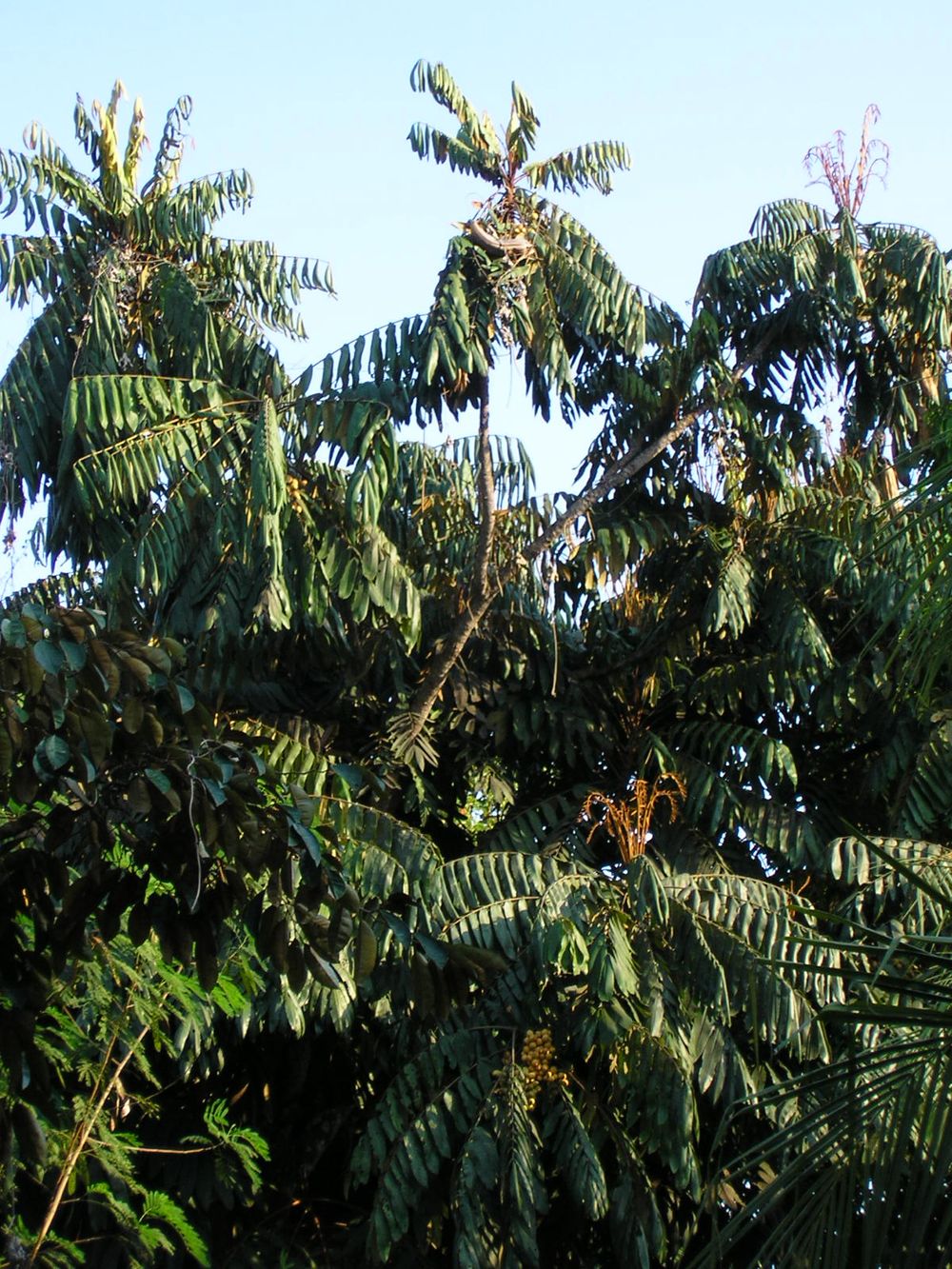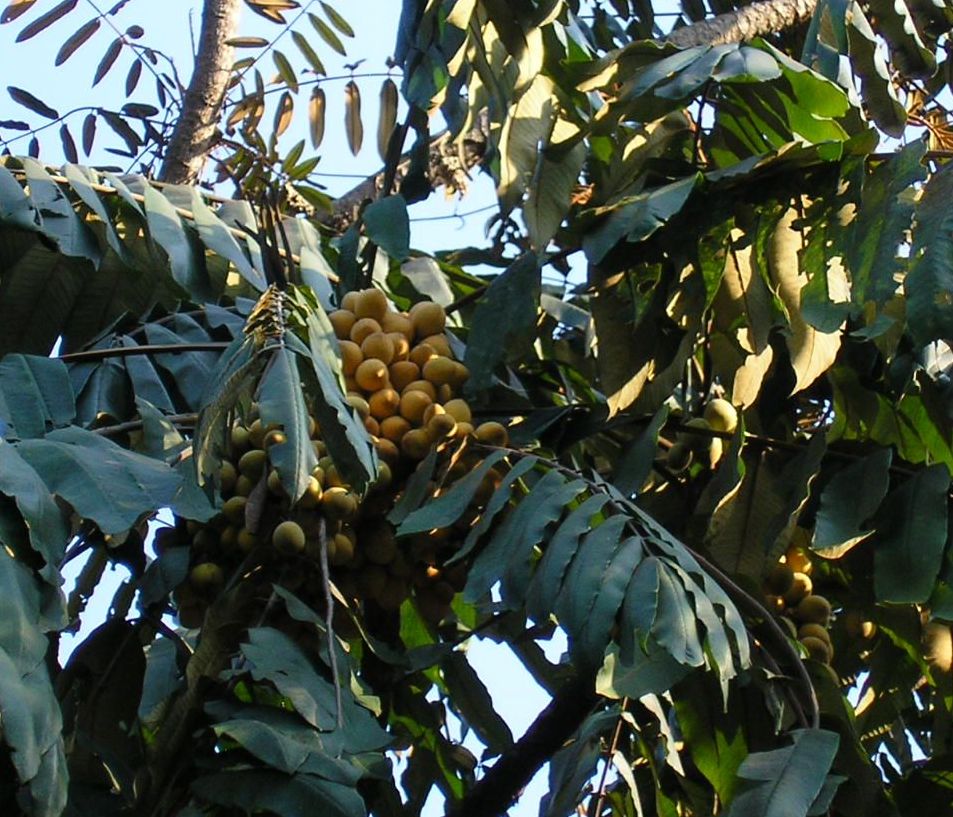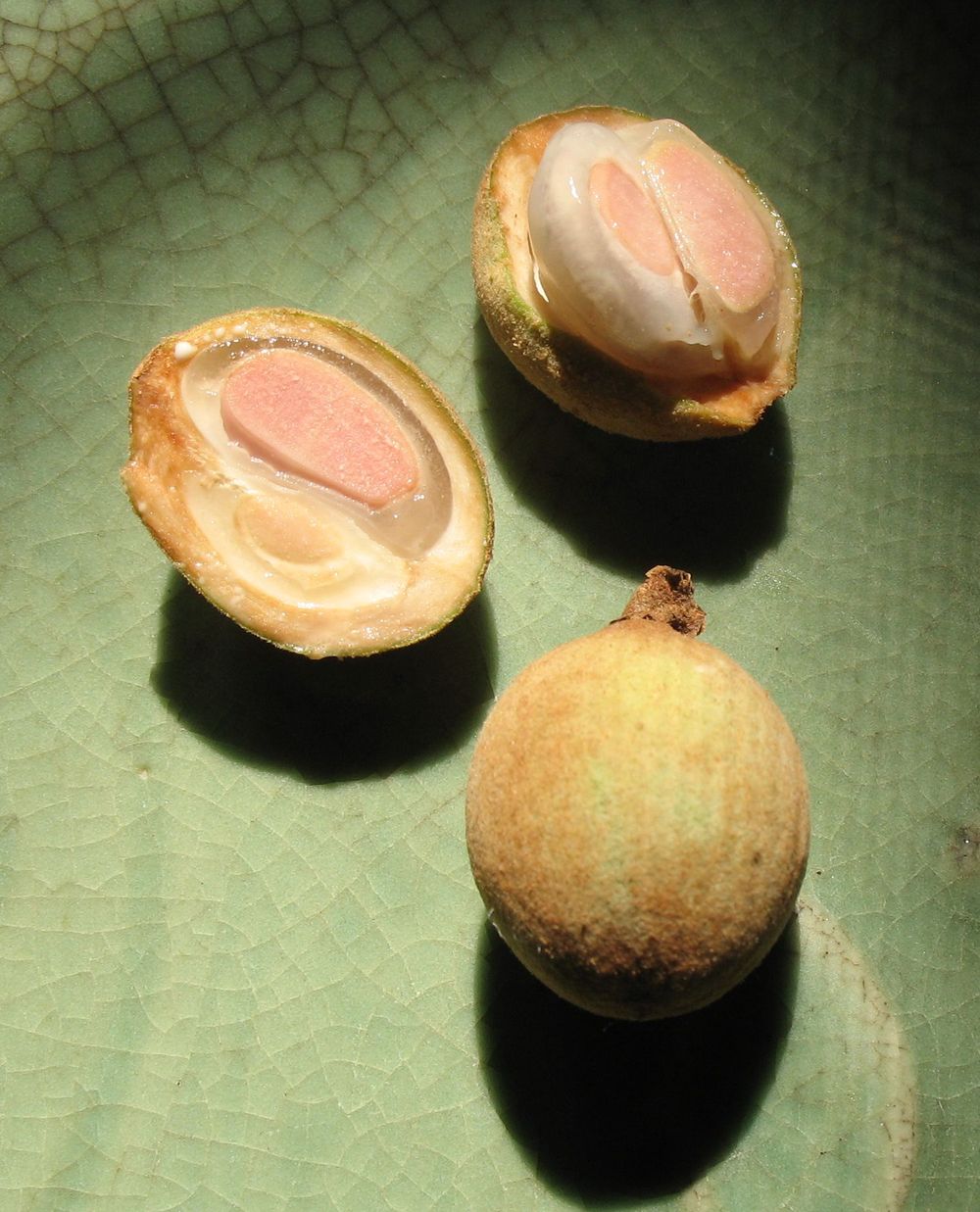Another rare tree seen in a pagoda on the banks of the Mekong near Vientiane.
Medium-sized, it is remarkable for its foliage, which consists of very long compound leaves with entire leaflets. Dark green in color, the lower leaves hang to the ground, while the higher ones rise to the top of the tree like a feather duster. Yellow fruits, 2 or 3cm in size, in large compact clusters, nestle in the hollows of these leaves.
The monk interviewed says that these are tone mak kong, and that the fruit is edible but highly acidic. In fact, the thin, translucent pulp surrounding the 2 or 3 large seeds is acidic, slightly astringent and reminiscent of the taste of Lansone (mak longkong).
Indeed, this tree belongs to the same genus as the delicious Lansones we’ve already mentioned; the smaller fruits have the same appearance and structure, but are practically inedible as is. Vidal classifies it as an Aglaia, a genus created in 1790 by Loureiro in homage to one of the three graces of Greek mythology, Aglaia or Aglaé; bearing in mind that Loureiro compiled the first herbarium in the Indochinese Peninsula, we can assume that our tree is also found in neighboring countries, even if we have not found a vernacular name for it. However, this genus poses a number of taxonomic problems due to the considerable morphological variations, with the number of species and their names varying greatly depending on the species concept under consideration; for example, the Lansones are called Aglaia domesticum and, more recently, Lansium domesticum, while only the family does not vary – the Meliaceae.
Tone mak kong, the bonze tells us, is a medicinal plant “which is good for health because it cleanses”, so it’s a good idea to use the fruit in various culinary preparations such as tam som (acid salad). Vidal observes that this tree is used against “foot scab”.
Alongside these uses, in another pagoda, we’re told that the wood from this tree is good for making tools, but we didn’t find it listed as a “wood tree”.
To conclude this brief overview, we can say that tone mak kong is poorly known to both Lao people and botanists.
Encore un arbre rare vu dans une pagode sur les bords du Mékong aux environs de Vientiane.
De taille moyenne il est remarquable par son feuillage formé de très longues feuilles composées aux folioles entières; de couleur vert foncé, ces feuilles, pour les plus basses, pendent vers le sol alors que les plus hautes se dressent au sommet de l’arbre comme un plumeau. Des fruits jaunes, de 2 ou 3cm, en grosses grappes compactes, se nichent au creux de ces feuilles. Le bonze interrogé dit qu’il s’agit de tone mak kong, que les fruits sont comestibles mais qu’ils sont très acides. En effet la mince pulpe translucide qui entoure les 2 ou 3 grosses graines est acide, légèrement astringente et rappelle le goût des Lansone (mak longkong).
Car cet arbre appartient au même genre que les délicieux Lansone dont nous avons déjà parlés; les fruits, en plus petits, en ont le même aspect et la même structure mais sont pratiquement immangeables tels quels. Vidal le range dans les Aglaia, genre créé en 1790 par Loureiro en hommage à l’une des trois grâces de la mythologie grecque, Aglaia ou Aglaé; lorsque l’on sait que Loureiro a constitué le premier herbier de la Péninsule indochinoise on peut penser que notre arbre se rencontre aussi dans les pays voisins même si nous n’y avons pas trouvé de nom vernaculaire. Ce genre pose cependant de nombreux problèmes taxinomiques à cause des importantes variations morphologiques, le nombre d’espèces et leur nom variant fortement selon le concept d’espèce considéré; ainsi les Lansone sont nommés Aglaia domesticum et, plus récemment, Lansium domesticum, seule la famille ne varie pas il s’agit des Méliacées.
Tone mak kong, nous dit le bonze, est une plante médicinale « qui est bonne pour la santé car elle nettoie », il est donc bien de mettre le fruit dans différentes préparations culinaires comme les tam som (salade acide). Vidal observe que cet arbre est employé contre « la gale des pieds ». A côté de ces usages, dans une autre pagode, on nous dit que le bois de cet arbre est bon pour faire des outils, mais nous ne l’avons pas trouvé répertorié comme « arbre à bois ».
Pour conclure ce bref aperçu, on peut dire que tone mak kong est mal connu et des Lao et des botanistes.



Another rare tree seen in a pagoda on the banks of the Mekong near Vientiane.
Medium-sized, it is remarkable for its foliage, which consists of very long compound leaves with entire leaflets. Dark green in color, the lower leaves hang to the ground, while the higher ones rise to the top of the tree like a feather duster. Yellow fruits, 2 or 3cm in size, in large compact clusters, nestle in the hollows of these leaves.
The monk interviewed says that these are tone mak kong, and that the fruit is edible but highly acidic. In fact, the thin, translucent pulp surrounding the 2 or 3 large seeds is acidic, slightly astringent and reminiscent of the taste of Lansone (mak longkong).
Indeed, this tree belongs to the same genus as the delicious Lansones we’ve already mentioned; the smaller fruits have the same appearance and structure, but are practically inedible as is. Vidal classifies it as an Aglaia, a genus created in 1790 by Loureiro in homage to one of the three graces of Greek mythology, Aglaia or Aglaé; bearing in mind that Loureiro compiled the first herbarium in the Indochinese Peninsula, we can assume that our tree is also found in neighboring countries, even if we have not found a vernacular name for it. However, this genus poses a number of taxonomic problems due to the considerable morphological variations, with the number of species and their names varying greatly depending on the species concept under consideration; for example, the Lansones are called Aglaia domesticum and, more recently, Lansium domesticum, while only the family does not vary – the Meliaceae.
Tone mak kong, the bonze tells us, is a medicinal plant “which is good for health because it cleanses”, so it’s a good idea to use the fruit in various culinary preparations such as tam som (acid salad). Vidal observes that this tree is used against “foot scab”.
Alongside these uses, in another pagoda, we’re told that the wood from this tree is good for making tools, but we didn’t find it listed as a “wood tree”.
To conclude this brief overview, we can say that tone mak kong is poorly known to both Lao people and botanists.
Encore un arbre rare vu dans une pagode sur les bords du Mékong aux environs de Vientiane.
De taille moyenne il est remarquable par son feuillage formé de très longues feuilles composées aux folioles entières; de couleur vert foncé, ces feuilles, pour les plus basses, pendent vers le sol alors que les plus hautes se dressent au sommet de l’arbre comme un plumeau. Des fruits jaunes, de 2 ou 3cm, en grosses grappes compactes, se nichent au creux de ces feuilles. Le bonze interrogé dit qu’il s’agit de tone mak kong, que les fruits sont comestibles mais qu’ils sont très acides. En effet la mince pulpe translucide qui entoure les 2 ou 3 grosses graines est acide, légèrement astringente et rappelle le goût des Lansone (mak longkong).
Car cet arbre appartient au même genre que les délicieux Lansone dont nous avons déjà parlés; les fruits, en plus petits, en ont le même aspect et la même structure mais sont pratiquement immangeables tels quels. Vidal le range dans les Aglaia, genre créé en 1790 par Loureiro en hommage à l’une des trois grâces de la mythologie grecque, Aglaia ou Aglaé; lorsque l’on sait que Loureiro a constitué le premier herbier de la Péninsule indochinoise on peut penser que notre arbre se rencontre aussi dans les pays voisins même si nous n’y avons pas trouvé de nom vernaculaire. Ce genre pose cependant de nombreux problèmes taxinomiques à cause des importantes variations morphologiques, le nombre d’espèces et leur nom variant fortement selon le concept d’espèce considéré; ainsi les Lansone sont nommés Aglaia domesticum et, plus récemment, Lansium domesticum, seule la famille ne varie pas il s’agit des Méliacées.
Tone mak kong, nous dit le bonze, est une plante médicinale « qui est bonne pour la santé car elle nettoie », il est donc bien de mettre le fruit dans différentes préparations culinaires comme les tam som (salade acide). Vidal observe que cet arbre est employé contre « la gale des pieds ». A côté de ces usages, dans une autre pagode, on nous dit que le bois de cet arbre est bon pour faire des outils, mais nous ne l’avons pas trouvé répertorié comme « arbre à bois ».
Pour conclure ce bref aperçu, on peut dire que tone mak kong est mal connu et des Lao et des botanistes.






Another rare tree seen in a pagoda on the banks of the Mekong near Vientiane.
Medium-sized, it is remarkable for its foliage, which consists of very long compound leaves with entire leaflets. Dark green in color, the lower leaves hang to the ground, while the higher ones rise to the top of the tree like a feather duster. Yellow fruits, 2 or 3cm in size, in large compact clusters, nestle in the hollows of these leaves.
The monk interviewed says that these are tone mak kong, and that the fruit is edible but highly acidic. In fact, the thin, translucent pulp surrounding the 2 or 3 large seeds is acidic, slightly astringent and reminiscent of the taste of Lansone (mak longkong).
Indeed, this tree belongs to the same genus as the delicious Lansones we’ve already mentioned; the smaller fruits have the same appearance and structure, but are practically inedible as is. Vidal classifies it as an Aglaia, a genus created in 1790 by Loureiro in homage to one of the three graces of Greek mythology, Aglaia or Aglaé; bearing in mind that Loureiro compiled the first herbarium in the Indochinese Peninsula, we can assume that our tree is also found in neighboring countries, even if we have not found a vernacular name for it. However, this genus poses a number of taxonomic problems due to the considerable morphological variations, with the number of species and their names varying greatly depending on the species concept under consideration; for example, the Lansones are called Aglaia domesticum and, more recently, Lansium domesticum, while only the family does not vary – the Meliaceae.
Tone mak kong, the bonze tells us, is a medicinal plant “which is good for health because it cleanses”, so it’s a good idea to use the fruit in various culinary preparations such as tam som (acid salad). Vidal observes that this tree is used against “foot scab”.
Alongside these uses, in another pagoda, we’re told that the wood from this tree is good for making tools, but we didn’t find it listed as a “wood tree”.
To conclude this brief overview, we can say that tone mak kong is poorly known to both Lao people and botanists.
Encore un arbre rare vu dans une pagode sur les bords du Mékong aux environs de Vientiane.
De taille moyenne il est remarquable par son feuillage formé de très longues feuilles composées aux folioles entières; de couleur vert foncé, ces feuilles, pour les plus basses, pendent vers le sol alors que les plus hautes se dressent au sommet de l’arbre comme un plumeau. Des fruits jaunes, de 2 ou 3cm, en grosses grappes compactes, se nichent au creux de ces feuilles. Le bonze interrogé dit qu’il s’agit de tone mak kong, que les fruits sont comestibles mais qu’ils sont très acides. En effet la mince pulpe translucide qui entoure les 2 ou 3 grosses graines est acide, légèrement astringente et rappelle le goût des Lansone (mak longkong).
Car cet arbre appartient au même genre que les délicieux Lansone dont nous avons déjà parlés; les fruits, en plus petits, en ont le même aspect et la même structure mais sont pratiquement immangeables tels quels. Vidal le range dans les Aglaia, genre créé en 1790 par Loureiro en hommage à l’une des trois grâces de la mythologie grecque, Aglaia ou Aglaé; lorsque l’on sait que Loureiro a constitué le premier herbier de la Péninsule indochinoise on peut penser que notre arbre se rencontre aussi dans les pays voisins même si nous n’y avons pas trouvé de nom vernaculaire. Ce genre pose cependant de nombreux problèmes taxinomiques à cause des importantes variations morphologiques, le nombre d’espèces et leur nom variant fortement selon le concept d’espèce considéré; ainsi les Lansone sont nommés Aglaia domesticum et, plus récemment, Lansium domesticum, seule la famille ne varie pas il s’agit des Méliacées.
Tone mak kong, nous dit le bonze, est une plante médicinale « qui est bonne pour la santé car elle nettoie », il est donc bien de mettre le fruit dans différentes préparations culinaires comme les tam som (salade acide). Vidal observe que cet arbre est employé contre « la gale des pieds ». A côté de ces usages, dans une autre pagode, on nous dit que le bois de cet arbre est bon pour faire des outils, mais nous ne l’avons pas trouvé répertorié comme « arbre à bois ».
Pour conclure ce bref aperçu, on peut dire que tone mak kong est mal connu et des Lao et des botanistes.


